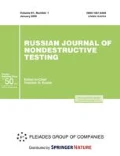Abstract
One of the most prevalent problems in grinding nickel-based super alloys is grinding wheel loading phenomenon which is the chip accumulation in free inter granular spaces between grains or micro-clogging on active vertices of abrasive grains. This research work studies the efficiency of acoustic emission signals in order to measure the grinding performance accompanied by wheel loading. Nickel based super alloy has been used as a work piece and experiments were carried out on different levels of wheel speed (vs), depths of wheel engagement (a) and work feed speeds (vf). The results showed that evaluation of acoustic emission parameter as well as root mean square of acoustic emission energy (AERMS) and acoustic emission amplitude are the appropriate tests to predict grinding performance.







Similar content being viewed by others
REFERENCES
Adibi, H., Rezaei, S., and Sarhan, A.A., Grinding wheel loading evaluation using digital image Processing, J. Manuf. Sci. Eng., 2014, vol. 136, no. 1, p. 011012.
Tamang, S.K. and Chandrasekaran, M., Integrated optimization methodology for intelligent machining of inconel 825 and its shop-floor application, J. Braz. Soc. Mech. Sci. Eng., 2016, https://doi.org/10.1007/s40430-016-0570-2
Adibi, H., Rezaei, S.M., and Sarhan, A.A., Investigation on using high-pressure fluid jet in grinding process for less wheel loaded areas, Int. J. Adv. Manuf. Technol., 2014, vol. 70, no. 9, pp. 2233–2240.
Li, Q., Xu, J., Su, H., and Lei, W., Fabrication and performance of monolayer brazed CBN wheel for high-speed grinding of superalloy, Int. J. Adv. Manuf. Technol., 2015, vol. 80, no. 5, pp. 1173–1180.
Zhao, Z., Fu, Y., Xu, J., and Zhang, Z., Behavior and quantitative characterization of CBN wheel wear in high-speed grinding of nickel-based superalloy, Int. J. Adv. Manuf. Technol., https://doi.org/10.1007/s00170-016-8686-1
Herzenstiel, P., Aurich, J. C., Cbn-grinding wheel with a defined grain pattern—extensive numerical and experimental studies, J. Mach. Sci. Technol., 2010, vol. 14, no. 3, pp. 301–322.
Gift, F.C., Misiolek, W.Z., and Force, E., Mechanics of loading for electroplated cubic boron nitride (CBN) wheels during grinding of a nickel-based superalloy in water-based lubricating fluids, J. Tribol., 2004, vol. 126, no. 4, pp. 795–801.
Sakamoto, H., Shimizu, S., and Kato, D., Evaluation of loading behaviour of grinding wheel based on working surface topography, Seimitsu Kogaku Kaishi, 1998, vol. 64, no. 9, pp. 1320–1324.
Srivastava, A., Ram, K.S., and Lal, G., A new technique for evaluating wheel loading, Int. J. Mach. Tool Des. Res., 1985, vol. 25, no. 1, pp. 33–38.
Kim, S. and Ahn, J.H., Decision of dressing interval and depth by the direct measurement of the grinding wheel surface, J. Mater. Process. Technol., 1999, vol. 88, no. 1, pp. 190–194.
Moia, D.F.G., Thomazella, I. H., Aguiar, P.R., Bianchi, E.C., Martins, C.H.R., and Marchi, M., Tool condition monitoring of aluminum oxide grinding wheel in dressing operation using acoustic emission and neural networks, J. Braz. Soc. Mech. Sci. Eng., 2015, vol. 37, no. 2, pp. 627–640.
Dornfeld, D. and Gao Cai, H., An investigation of grinding and wheel loading using acoustic emission, J. Manuf. Sci. Eng., 1984, vol. 106, no. 1. https://doi.org/10.1115/1.3185907
Griffin, J.M. and Torres, F., Dynamic precision control in single-grit scratch tests using acoustic emission signals, Int. J. Adv. Manuf. Technol., 2015, vol. 81, no. 5, pp. 935–953.
Zhang, D., Bi, G., Sun, Z., and Guo, Y., Online monitoring of precision optics grinding using acoustic emission based on support vector machine, Int. J. Adv. Manuf. Technol., 2015, vol. 80, no. 5, pp. 761–774.
Mokbel, A.A. and Maksoud, T., Monitoring of the condition of diamond grinding wheels using acoustic emission technique, J. Mater. Process. Technol., 2000, vol. 101, no. 1, pp. 292–297.
Karpuschewski, B., Wehmeier, M., and Inasaki, I., Grinding monitoring system based on power and acoustic emission sensors, CIRP Ann. Manuf. Technol., 2000, vol. 49, no. 1, pp. 235–240.
Malkin, S. and Anderson, R., Thermal aspects of grinding: part 1—energy partition, J. Eng. Ind., 1974, vol. 96, no. 4, pp. 1177–1183.
Cai, H.G., An investigation of grinding and wheel loading using acoustic emission, J. Eng. Ind., 1984, vol. 106, p. 28.
Krishnaiah, K. and Shahabudeen, P., Applied design of experiments and taguchi methods, J. Eng Ind., New Delhi: PHI Learn. Private Ltd., 2012.
Author information
Authors and Affiliations
Corresponding authors
Rights and permissions
About this article
Cite this article
Hamed Adibi, Ashtiani, A.S. & Rahimi, A. In-Process Monitoring of Nickel-Based Super Alloy Grinding Using the Acoustic Emission Method. Russ J Nondestruct Test 55, 909–917 (2019). https://doi.org/10.1134/S1061830919120027
Received:
Revised:
Accepted:
Published:
Issue Date:
DOI: https://doi.org/10.1134/S1061830919120027



